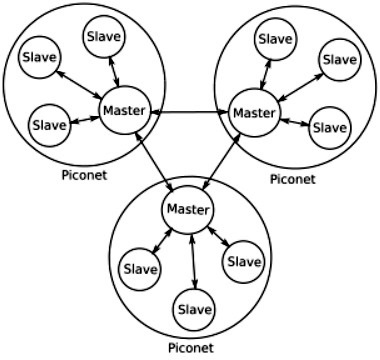Bluetooth is a wireless technology for short range communication. It's application ranges from wireless computer mouse, keyboard, headset, and printer, to home security and wearable health and sports monitoring devices. It uses the Uses 2.4 GHz (2400 - 2483.5 MHz) ISM (Industrial, Scientific and Medical) spread spectrum radio band.
The ISM radio band is used by microwave ovens, cordless phones, garage door openers, and other common devices, so it can be noisy. Bluetooth provides functionality to detect nearby Bluetooth devices, and in order to mitigate interference, implements frequency hopping.
To detect nearby Bluetooth devices a master device Sends out an inquire, which is a request for nearby devices (within 10 meters) to issue a response that allows them to be discoverable. A master device can also work in slave mode and issue a response that allows them to accept connection to another master device. A slave device can not initiate a connection, only accept connections. Note that nearby devices where the signal is blocked by something like a metal file cabinet can be undiscoverable.

Bluetooth Scatternet
Up to 8 Bluetooth devices can be connected in master/slave configuration called a Piconet There can be up to 7 active slaves for each master. A three bit address (AM_ADDR) is given to each active slave. Piconets can be combined to form scatternets providing unlimited device connectivity.
Inquiry Procedure
• To be found by other Bluetooth devices, the first device must be set to discoverable mode, this allows other Bluetooth devices within the discoverable distance to detect its inquire and issue a response in attempt to establish a connection.
• When two devices find each other they detect what type of device they are, cellphone, headset, etc., along with its Bluetooth device name. The Bluetooth device name is assigned by the manufacturer, or it can be assigned by the user.
• The two devices agree on a code they will use for passkeys and the master device sends a passkey.
• The slave device sends the passkey and the passkeys are compared and if they are both the same, a trusted pair is formed and a Bluetooth connection is established.
• Once the Bluetooth pairing has occurred, communication can be exchanged between the devices.
As stated earlier, the ISM radio band used by Bluetooth devices is also used by many other common devices like microwave ovens, cordless phones, garage door openers, so it can be noisy. In order to mitigate interference, Bluetooth implements frequency hopping. With frequency hopping the master uses preprogrammed frequency tuning sequence to hop from channel frequency to channel frequency using 79 communication channels. It can change the communication frequency for each data packet. All slaves in a piconet follow the same preprogrammed frequency hop sequence.
Bluetooth Modes
Bluetooth devices operate in standby mode by default until they become connected. After a device has completed the connection process, it enters one of 4 connection modes.
Active Mode - The device is actively transmitting or receiving data.
Sniff Mode - This is a low power mode, where the device only listens for transmissions at a set interval.
Hold Mode - This is a low power mode where a device sleeps for a defined period and then returns to active mode. The master can command a slave device to hold.
Park Mode - This is a low power mode where the master commands a slave to become inactive until the master tells it to wake up.
Bluetooth is one of the technologies that will be involved in the IOT (Internet Of Things), a scheme to interconnect devices from your home light switches and thermostat, to your coffee maker, microwave oven, and billions of other devices.
More Networking Basics:
• What You Need to Know About a Career as a Network Engineer
• What is Port Forwarding?
• Fiber Optic Cabling For Beginners
• Satellite Broadband Internet Service
• Network Patch Panel Basics
• Computer Networking Basics
• What Routers Do
• Introduction To IP Addressing and Networking
• Cloud Delivery Models
• Bluetooth in Brief

